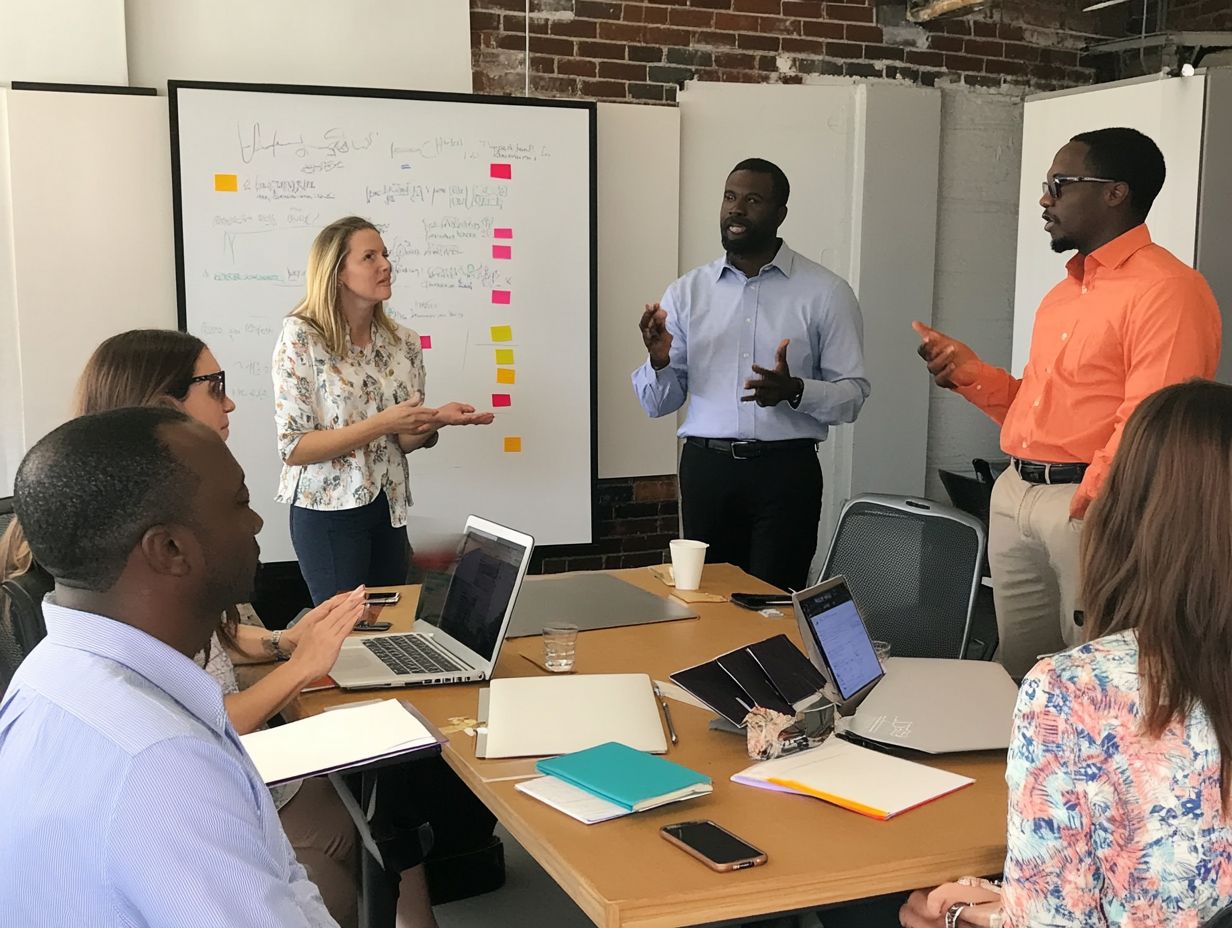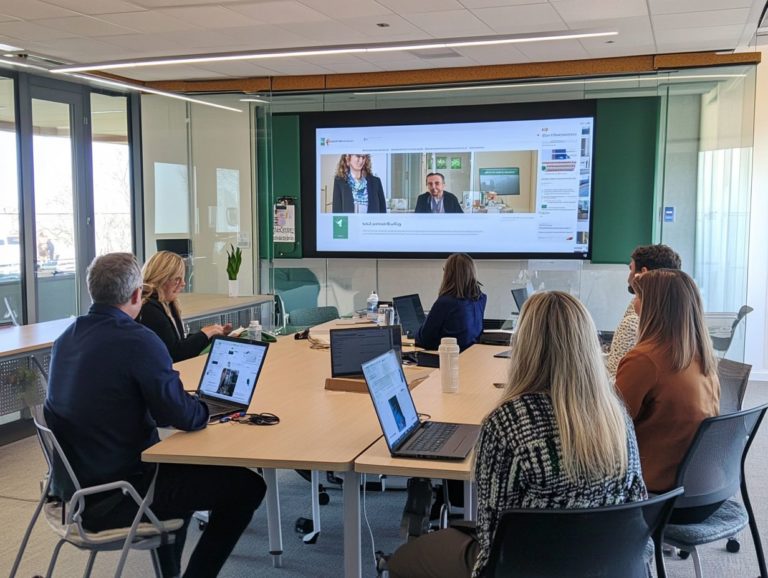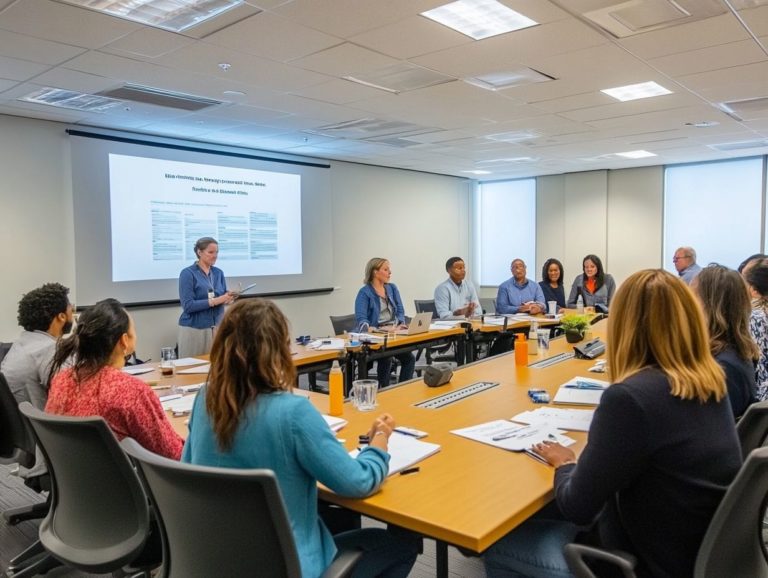What Are the Challenges of Training a Diverse Workforce?
In today s interconnected world, grasping the details of diversity in the workplace is more essential than ever. As organizations endeavor to embrace a rich tapestry of perspectives and backgrounds, they encounter distinct challenges in training their diverse workforce. Let s explore how we can overcome these obstacles together!
You ll need to navigate communication barriers and cultural differences while also addressing unconscious bias, which refers to judgments we make without realizing it. The journey toward inclusivity is undeniably complex.
This article delves into effective strategies for diversity training, measures to evaluate its success, and approaches to overcome resistance. This ensures that your organization can flourish in a vibrant and diverse environment.
Explore with us as we unravel the intricacies of fostering a more inclusive workplace.
Contents
- Key Takeaways:
- Understanding Diversity in the Workplace
- The Challenges of Training a Diverse Workforce
- Strategies for Effective Diversity Training
- Measuring the Success of Diversity Training
- Overcoming Resistance to Diversity Training
- Addressing Resistance and Promoting Buy-In
- Frequently Asked Questions
- What are the challenges of training a diverse workforce?
- How can language barriers affect training for a diverse workforce?
- What are some strategies for addressing language barriers in training?
- Why is it important to consider different learning styles when training a diverse workforce?
- How can cultural differences impact training for a diverse workforce?
- What are some ways to ensure inclusivity and diversity in training programs?
Key Takeaways:

- Effective diversity training requires understanding and embracing the concept of diversity, its importance, and its impact on the workplace.
- Communication and cultural differences, along with unconscious bias, present challenges in training a diverse workforce. Addressing these obstacles is crucial for successful training.
- Strategies for effective diversity training include creating an inclusive environment and tailoring the training to cater to different learning styles. Measuring and addressing resistance to diversity training is also essential for its success.
Understanding Diversity in the Workplace
Understanding diversity in the workplace is essential for cultivating a culture of inclusion, where you and your colleagues from various backgrounds can thrive, collaborate, and enhance the organization s overall productivity and innovation.
A diverse workforce brings together unique perspectives that amplify problem-solving capabilities and drive engagement both vital in today s exciting global economy.
By recognizing and valuing cognitive diversity, which refers to different ways of thinking, and demographic diversity, which encompasses factors like age, gender, and ethnicity, you enable your organization to adapt more effectively to shifting markets and societal needs. Furthermore, embracing generational differences can significantly improve relationships among employees and foster a sense of belonging. This creates a supportive environment that encourages your development and well-being.
Defining Diversity and its Importance
Diversity in the workplace signifies the rich tapestry of perspectives, backgrounds, and experiences among employees. This variety is essential for cultivating an inclusive culture and fueling innovation.
This concept encompasses several dimensions, including cognitive diversity, which emphasizes different approaches to thinking and problem-solving, and demographic diversity, representing factors like age, gender, and ethnicity. It also includes generational diversity, drawing on insights from various age groups.
Organizations that truly embrace diversity often witness enhanced team dynamics, where a blend of ideas creates an environment ripe for creativity and stronger solutions.
For instance, imagine a team composed of individuals from diverse cultural backgrounds. This diversity can lead to innovative marketing strategies that attract a wider audience. By implementing effective management strategies, you can harness this diversity to elevate employee engagement, ultimately leading to increased productivity and improved overall performance.
The Challenges of Training a Diverse Workforce
Training a diverse workforce brings forth unique challenges that you must navigate to cultivate an inclusive and equitable workplace culture. One area to consider is the challenges of training in a hybrid workplace, as these issues often arise from cultural differences and communication barriers, which can lead to misunderstandings and conflicts.
Unconscious biases can influence how effective training is perceived, making it essential for you to address discrimination and devise tailored strategies that foster learning and growth for every employee.
Acknowledging these issues is the crucial first step in crafting effective training programs that enhance collaboration and strengthen team dynamics.
Let s take these insights and make a real impact!
Communication and Cultural Differences
Cultural differences can profoundly influence your communication strategies in the workplace. If not thoughtfully addressed, they can lead to misunderstandings and conflicts.
In today s globalized landscape, team interactions are increasingly shaped by diverse backgrounds. Differences in communication styles, such as varying levels of openness and directness, can create friction among team members. As platforms like Slack and Zoom enable remote collaboration, recognizing these cultural nuances is essential.
Adopting active listening is a vital strategy to bridge communication gaps. This allows individuals to express their perspectives freely and without bias.
Building relationships through regular check-ins and acknowledging cultural holidays or traditions fosters a more inclusive atmosphere. This proactive approach enhances collaboration and boosts productivity.
Addressing Unconscious Bias

Addressing unconscious bias is crucial for creating a fair and inclusive workplace. These biases can subtly influence your hiring practices, promotions, and team interactions.
Often, biases stem from backgrounds, experiences, and societal norms. This can lead to decisions that unintentionally favor certain groups, undermining the principles of equitable inclusion and impacting employee morale and organizational productivity.
To tackle this issue, organizations should implement comprehensive training programs that raise awareness about these biases. These programs equip employees with the tools to recognize them. For instance, a tech company adopted a strategy that included regular workshops and bias-intensity assessments, resulting in significant improvements in diverse hiring metrics.
By fostering an environment of support and openness, companies can mitigate unconscious bias and promote a richer, more inclusive corporate culture.
Strategies for Effective Diversity Training
Implementing effective strategies for diversity training is essential for ensuring every employee feels supported and included. This enhances both engagement and productivity.
Organizations should tailor training programs to meet their workforce’s unique needs, considering diverse learning styles and perspectives. Prioritizing employee development cultivates a culture that values diversity and drives innovation.
Creating an Inclusive Training Environment
Creating an inclusive training environment is crucial for fostering a genuine sense of belonging among all employees, particularly in diverse workplaces.
This requires recognizing the unique perspectives each employee contributes and actively integrating varied voices into the training process. Open communication is vital; as a trainer, encourage dialogue and feedback, allowing participants to share their experiences without hesitation.
Establishing mutual respect is key. Everyone should feel valued, regardless of their background.
Incorporating diverse case studies or role-playing scenarios resonates with employees from different cultures, emphasizing their significance within the learning framework. Accessibility is also fundamental. Providing materials in multiple formats ensures that everyone can engage meaningfully in training sessions, enhancing the overall employee experience.
To learn more and implement these strategies, organizations should seek additional resources and training opportunities.
Tailoring Training to Different Learning Styles
Tailoring training programs to accommodate various learning styles is crucial for maximizing the effectiveness of your diversity training initiatives. Each employee absorbs information differently, so creating an engaging environment is vital.
Incorporating interactive elements, such as group discussions or hands-on activities, can significantly elevate learning outcomes. Offering training materials in various formats like videos, articles, or presentations ensures every employee connects with the content.
Flexibility in your training methods enhances skill acquisition and fosters a culture of inclusivity and respect. These are essential for sustained employee development.
Measuring the Success of Diversity Training
Measuring the success of diversity training programs is vital for understanding their impact on workplace culture and employee engagement. Evaluating outcomes helps identify areas for improvement.
Gathering employee feedback and analyzing engagement metrics allows for a thorough assessment of training effectiveness. This approach enhances training programs and nurtures a culture of accountability and commitment to diversity and inclusion.
Evaluating Impact and Making Improvements

Evaluating the impact of Diversity Training helps you understand effectiveness and guides future improvements. Analyzing various metrics and gathering feedback offers insights into how programs resonate with participants.
This evaluation should include pre- and post-training assessments, along with ongoing surveys and focus groups. For example, a major tech firm assessed its program using metrics like employee retention rates and workplace satisfaction.
Through careful evaluation, you can identify areas needing adjustment and refine training methods. This creates a more inclusive and supportive work environment that adapts to evolving workplace dynamics.
Overcoming Resistance to Diversity Training
Overcoming resistance to diversity training is a significant challenge for organizations aiming to build an inclusive workplace culture. This resistance can stem from various factors, like preconceived notions and a lack of understanding about its importance.
Implementing strategies to encourage buy-in from employees and leadership is crucial. Addressing concerns and promoting open communication facilitates a smoother transition toward fully embracing diversity initiatives.
Addressing Resistance and Promoting Buy-In
Addressing resistance to diversity training calls for targeted strategies that effectively promote buy-in and enhance employee engagement throughout the process.
To achieve this, initiate open discussions that allow employees to voice their concerns. This creates an atmosphere of transparency and trust.
Workshops play a crucial role. They offer valuable insights into the significance of diversity and include team-building exercises that foster collaboration.
Regular feedback sessions are essential for gathering input from employees. This helps identify possible obstacles while motivating individuals to engage.
Highlighting the exciting benefits can really motivate employees! For example, one company that adopted these methods experienced a 30% increase in participation rates in their diversity initiatives. This showcases the effectiveness of these practical approaches.
Frequently Asked Questions
What are the challenges of training a diverse workforce?
The challenges of training a diverse workforce include language barriers, different learning styles, and cultural differences that may affect the effectiveness of training. To better understand these issues, consider exploring common challenges in corporate training.
How can language barriers affect training for a diverse workforce?

Language barriers can make it difficult for employees to understand the training material, leading to a lack of comprehension and retention.
What are some strategies for addressing language barriers in training?
Some strategies for addressing language barriers include providing translated materials, using visual aids, and offering language support during training sessions.
Why is it important to consider different learning styles when training a diverse workforce?
Individuals from diverse backgrounds may have different learning styles. It s important to provide training that caters to various methods of learning.
How can cultural differences impact training for a diverse workforce?
Cultural differences can lead to misunderstandings or differences in expectations, which may affect the effectiveness of training. It’s crucial to be culturally sensitive when designing training for a diverse workforce.
What are some ways to ensure inclusivity and diversity in training programs?
Incorporating diverse perspectives and examples in training materials, providing a safe space for open discussion, and actively seeking feedback from employees of different backgrounds are key to ensuring inclusivity and diversity in training programs.
Explore our training programs to foster a more inclusive workplace today!





